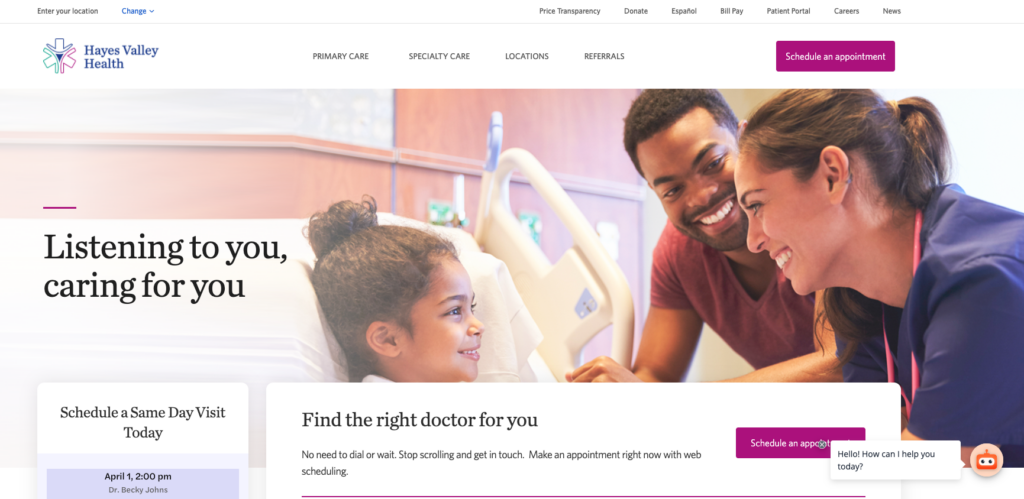AI That Delivers Results: Tips for Healthcare Leaders

At Luma, we believe the healthcare industry has moved beyond the initial hype of artificial intelligence (AI). While AI once dominated conversations with grand promises and speculative claims, it has now become table stakes. The industry is entering a new phase, one where AI is treated like any other technology investment — evaluated with rigor and held accountable for delivering real outcomes. For healthcare leaders, this shift requires a focus on practical applications and measurable impact.
AI should not be designed or deployed with the intent to replace your workforce. Instead, it enables your workforce to focus on patient-facing interactions over administrative busywork.
To explore what this shift looks like in practice, in this blog post we’ll follow the journey of Hayes Valley Health Center, a mid-sized hospital navigating the realities of AI adoption. Hayes Valley is fictional, but its challenges are anything but. Modeled after the experiences of Luma customers, the health center faces mounting pressure to improve operational efficiency, deliver high-quality care, and enhance experiences for both patients and staff. Like many health systems, they’re excited by AI’s potential but have struggled to move beyond the buzzwords.

Throughout this post, we’ll explore how Hayes Valley Health Center approaches AI adoption with a focus on outcomes, applying the same level of diligence and strategic thinking they would with any other technology. From identifying clear goals to measuring success, their story serves as a practical guide for healthcare organizations striving to turn AI’s promise into real-world progress.
AI as a Productivity Booster, Not a Workforce Replacement
Like many health systems, Hayes Valley’s leadership initially viewed AI as a way to reduce staff costs. They hoped that chatbots could replace human schedulers, handling appointment management and patient inquiries with minimal human intervention. It seemed like a quick win to drive efficiency and lower expenses.
The reality didn’t match expectations. While the AI chatbot excelled at simple tasks, it struggled with more complex patient requests. Patients seeking specialized care, needing to reschedule complicated procedures, or asking detailed insurance questions grew frustrated. Staff often had to step in without sufficient context, leading to inefficiencies and dissatisfaction on both sides.
Recognizing this challenge, Hayes Valley recalibrated their approach. Instead of positioning AI as a replacement for human schedulers, they deployed it as a productivity booster. The AI was assigned three key tasks:
- Routine appointment confirmations: automating simple interactions to save staff time.
- Rescheduling requests: managing straightforward scheduling changes.
- Frequently Asked Questions: providing quick answers to common inquiries.
This shift freed staff to focus on higher-value patient interactions. Without the burden of routine tasks, they could provide more compassionate and personalized support. AI operated behind the scenes to streamline workflows, while human schedulers brought empathy and expertise to complex situations. The result was a better experience for both patients and employees.
Luma’s AI-powered Navigator product supports this kind of balanced approach. Navigator uses conversational AI to assist with appointment management and patient inquiries, ensuring staff can dedicate their time to what matters most. By handling the repetitive, AI enables healthcare organizations to scale their services without sacrificing quality.
The key lesson Hayes Valley learned is clear: AI is not a substitute for human expertise. Instead, it’s a powerful tool to enhance productivity, reduce operational friction, and improve care experiences. When thoughtfully applied, AI empowers staff to excel in their roles, making healthcare more efficient and empathetic for all.
Prioritizing Real Use Cases Over Shiny Tech
What can all of us learn from the missteps of the fictional Hayes Valley? We must shift focus to AI solutions designed to solve practical, high-impact problems, and it should integrate seamlessly with existing systems and staff workflows.
Before adopting any new AI tool we recommend asking four critical questions, based on input from health system leaders we work with who have successfully adopted and deployed AI:
- Does it solve a real problem? Solutions should address specific operational or clinical challenges, not just add novelty. Select a single, targeted operational problem (clinical applications of AI likely will be more complex to implement) and start there.
- Can staff actually use it? AI needs to be intuitive and empower staff, not require extensive retraining or IT intervention. If possible, involve end users in the evaluation process for any AI tool that they’llbe expected to work with. Educate any frontline staff using an AI tool about its purpose: to support their work by reducing administrative tasks, not to replace them.
- Does it integrate with existing systems? Interoperability is essential. Disjointed AI tools create more headaches than they solve. Ask AI vendors specifically about how many years of experience they have integrating with your EHR. Speak with at least two reference customers who have worked with the vendor for a minimum of one year.
- Is it easily measurable? Without proper measurement, the value of AI tools will be unclear. Identify 1-3 specific metrics that inform progress on the problem the AI tool is addressing, then measure those metrics regularly to ensure that it’s truly delivering value. In addition, consult with your AI vendor to understand whether there are additional metrics to track to drive continuous improvement of the AI learning and performance.
Future-proofed, AI-native platforms like Luma’s are designed with these principles in mind. Built to adapt and grow with healthcare organizations, they ensure today’s AI solutions won’t become tomorrow’s technical debt. Platforms that anticipate industry needs and prioritize interoperability are the ones that will drive lasting impact.
Moving Forward with Practical AI
Hayes Valley Health Center’s journey offers lessons for effectiveAI adoption — avoid the hype, invest in practical solutions, and ensure AI tools support (rather than replace) healthcare teams.
By aligning AI investments with clear goals, empowering staff with adaptable tools, and maintaining a disciplined roadmap, organizations can drive meaningful improvements.
The key takeaway is simple: AI should empower, not complicate. With the right mindset and technologies, AI can become a powerful tool for transforming healthcare—enhancing experiences, improving outcomes, and making care more accessible for all.